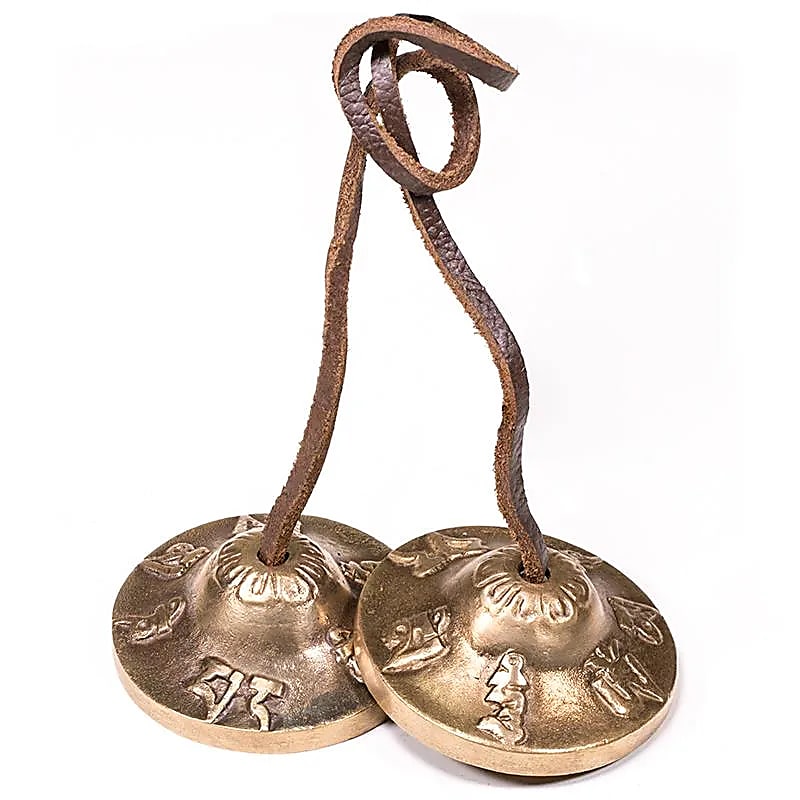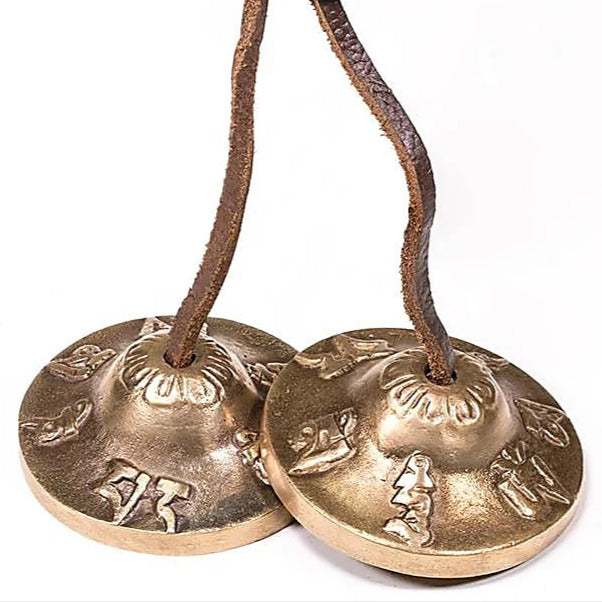Tibetan Cymbal/Tingsha with engraved Mantra 'OMPH', 3 sizes to choose from from 6 to 7.5 cm. Used as musical offerings!
Tibetan Cymbal/Tingsha with engraved Mantra 'OMPH', 3 sizes to choose from from 6 to 7.5 cm. Used as musical offerings!
Couldn't load pickup availability
- ✧─────✧
About the product:
→ Tibetan Cymbal - Tingsha or Ding-Sha's
🌍 Origin: Nepal - Tibet - Bhutan - China
📐 Dimensions/ ⚖️ Weight:
- Reference 19134 = 6 centimeters - +/- 212 grams
- Reference 19135 = 6.7 centimeters = +/- 261 grams
- Reference 19136 = 7.2 centimeters = +/- 314 grams
🧬 Materials: Copper + Bronze
📦 Packaging: Per pair
🎁 Ideal for giving as a gift or treating yourself!
🏷️ Option: If you want covers in typical Nepalese brocade: Click here
→ See all Tingsha models: Click here
🎶 An Asian percussion instrument often used by dancers including belly dancers.
They are small without any specific tone.
They are usually attached to the thumb and middle finger of one or both hands and struck together in a specific rhythm that usually accompanies other instruments.
These cymbals are an excellent instrument for developing a sense of rhythm, and/or improving it in children and adults. They are mainly used in sets of 2 at a time, one for each hand.
The Mantra “Om Mani Padme Hum” , one of the most famous in Tibetan Buddhism.
🔹 Meaning of the mantra
- Om : universal vibration, the source of everything.
- Mani : the jewel (symbol of compassion).
- Padme : the lotus (symbol of wisdom and purity).
- Hum : the awakened mind, the union of wisdom and compassion.
👉 As a whole, “Om Mani Padme Hum” can be translated as:
“The jewel is in the lotus,” a metaphor for spiritual awakening: in the midst of suffering (lotus mud), wisdom and compassion can blossom.
🔹 Origin
- Mantra associated with Chenrezig (Avalokiteshvara) , bodhisattva of infinite compassion.
- Inscribed for centuries on stones, prayer wheels, Tibetan flags.
- Recited by practitioners to develop universal love and compassion .
🔹 Benefits
- Calms the mind and promotes concentration in meditation.
- Develop compassion for yourself and others .
- Purifies karma and harmonizes energy.
- Elevated to the rank of mantra of healing and inner peace .
🔹 Practical
- Traditionally recited 108 times with a mala.
- Can be sung aloud (mantra chanting), whispered or simply repeated mentally.
- Often associated with meditation on universal compassion .
📋 Fact sheet:
| Property | Details |
|---|
| Name | Tingsha (ཏིང་ཤ་) – Tibetan cymbals |
| Nature | Buddhist ritual and musical object |
| Composition | Traditional alloy of metals (bronze, copper, brass, sometimes silver) |
| Appearance | Two small cymbals connected by a rope or leather strap |
| Origin / Use | Tibet, Nepal, India; used in Buddhism and shamanic rituals |
| Sound | Clear, crystalline and prolonged sound, considered to be purifying |
| Virtues / Symbolism | - Purification of negative energies 🔔 - Promotes meditation and concentration - Energy harmonization tool |
| Spiritual Use | - Opening/closing rituals - Support for meditation and yoga - Energy cleaning of places and stones |
| Purification | Not intended as a stone, but used to purify |
| Recharging | Not applicable (ritual object) |
| Value | Varies depending on age, alloy, size and ornamentation |
| Short story / Anecdote | Tingsha are often decorated with Buddhist symbols (8 auspicious signs). Their sound is said to represent the primordial vibration that connects the material and spiritual worlds. |
- ✧─────✧
A question? A comment? | Order and delivery information
A question? A comment? | Order and delivery information
⋯⋯⋯⋯⋯⋯⋯⋯⋯⋯⋯⋯⋯⋯⋯⋯⋯⋯⋯⋯
📞 Customer service available from Tuesday to Saturday , from 10am to 7pm (French time)
- 🇫🇷 From France: 06 51 85 38 18
- 🌍 From abroad: +33 6 51 85 38 18
- 💬 Live chat: via the bubble in the bottom right corner of your screen
- 📧 Email : available 24/7 – we respond quickly!
⋯⋯⋯⋯⋯⋯⋯⋯⋯⋯⋯⋯⋯⋯⋯⋯⋯⋯⋯⋯
🔖 Order today and receive your package within 2 to 10 days depending on your continent.
💳 Secure payment & certified by SSL encryption 🔐
↩️ Returns & exchanges possible within 14 to 30 days after receipt.
🌍 Shipping costs are calculated automatically based on your shipping address at checkout.
📦 Country of shipment: France 🇫🇷
Share





